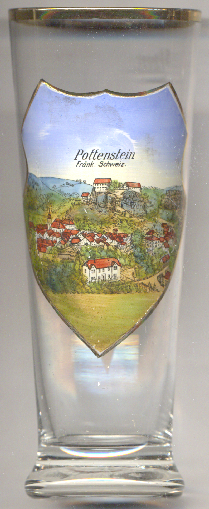

|
| DEUTSCHLAND | GERMANY |
| Bundesland: Freistaat Bayern | Bavaria |
| Regierungsbezirk: Oberfranken | |
| Landkreis: Bayreuth |
 Pottenstein is situated at an elevation of 368 m in the nature reserve Fränkische Schweiz/Veldensteiner Forst in
Upper Franconia, about 23 km southwest of the district town Bayreuth, about 43 km
northeast of Nuremberg, and about 184 km north of Munich. The
municipality has a population of about 5,200 (2023).
Pottenstein is situated at an elevation of 368 m in the nature reserve Fränkische Schweiz/Veldensteiner Forst in
Upper Franconia, about 23 km southwest of the district town Bayreuth, about 43 km
northeast of Nuremberg, and about 184 km north of Munich. The
municipality has a population of about 5,200 (2023).
The history of Pottenstein can be traced back to the first documented mention in 918. Pottenstein Castle was built around 1060. In 1323, the town was granted town rights. Pottenstein was the seat of a high bailiff of the prince-bishopric of Bamberg. In 1739, alarge fire destroyed the town completely. Thus, today, the only buildings in Pottenstein that predate this year are the castle and the Bürgerspital ('Citizens' hospice'). Since the Reichsdeputationshauptschluss of 1803, Pottenstein was part of the Electorate (1806 Kingdom) of Bavaria. As part of the administrative reforms in the kingdom, the municipality was established with the Municipal Edict of 1818. Until the local governments reorganisation of 1972, Pottenstein was part of the district Pegnitz. After the dissolution of the old district Pegnitz was re-allocated into the district Bayreuth.
 Pottenstein Castle [left, no. 4772: background centre] is one of the oldest
castles in the 'Franconian Switzerland' region. It is located at a height of roughly 410 m on a west-facing hill spur
between the valleys of the Püttlach and the Weihersbach, immediately southeast and above the town of Pottenstein.
The castle was built between 1057 and 1070, likely for protecting the area between the upper Main and Pegnitz to the south east.
Since the early 12th century, the castle was in possession of the bishops of Bamberg. During the following centuries,
Pottenstein Castle was entrusted by the bishops of Bamberg to a ministerial family who renamed themselves after the castle.
From 1227 to 1228 Pottenstein Castle served as a temporary, but likely forced, residence for Saint Elizabeth, Landgravine of
Thuringia. Between 1323/1327 and 1348 the castle became the seat of an 'Amt' or administrative base for the Bishopric of Bamberg.
Pottenstein was the centre of an extensive judicial district. The administrative area of Pottenstein was enlarged by the
incorporation of smaller episcopal offices: in 1492 the Amt of Tüchersfeld, in 1594 Amt Leienfels and in 1628–1636
Amt Gößweinstein. After the transfer of the secular domains of the bishopric n 1803 to the
Bavarian state, the castle fell into ruins. After 1878, under private ownership, the first attempts to preserve the structure
were made. The castle is now a privately run museum and residence where prehistoric and early historical objects are displayed
along with a collection of weapons, books, autographs and three show rooms grouped as an ensemble.
Pottenstein Castle [left, no. 4772: background centre] is one of the oldest
castles in the 'Franconian Switzerland' region. It is located at a height of roughly 410 m on a west-facing hill spur
between the valleys of the Püttlach and the Weihersbach, immediately southeast and above the town of Pottenstein.
The castle was built between 1057 and 1070, likely for protecting the area between the upper Main and Pegnitz to the south east.
Since the early 12th century, the castle was in possession of the bishops of Bamberg. During the following centuries,
Pottenstein Castle was entrusted by the bishops of Bamberg to a ministerial family who renamed themselves after the castle.
From 1227 to 1228 Pottenstein Castle served as a temporary, but likely forced, residence for Saint Elizabeth, Landgravine of
Thuringia. Between 1323/1327 and 1348 the castle became the seat of an 'Amt' or administrative base for the Bishopric of Bamberg.
Pottenstein was the centre of an extensive judicial district. The administrative area of Pottenstein was enlarged by the
incorporation of smaller episcopal offices: in 1492 the Amt of Tüchersfeld, in 1594 Amt Leienfels and in 1628–1636
Amt Gößweinstein. After the transfer of the secular domains of the bishopric n 1803 to the
Bavarian state, the castle fell into ruins. After 1878, under private ownership, the first attempts to preserve the structure
were made. The castle is now a privately run museum and residence where prehistoric and early historical objects are displayed
along with a collection of weapons, books, autographs and three show rooms grouped as an ensemble.
Another glass in this collection is a souvenir from
Pottenstein, Austria.
Pottenstein is also the the former German name of Potštejn, Czech Republic.
[https://de.wikipedia.org/wiki/Pottenstein_(Oberfranken);
https://de.wikipedia.org/wiki/Burg_Pottenstein, https://en.wikipedia.org/wiki/Pottenstein_Castle]
![[scale]](lineal.jpg)